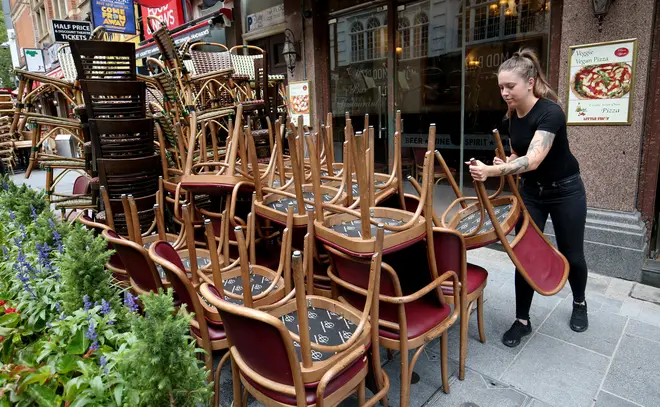
Ali Miraj 12pm - 3pm
3 July 2020, 17:47

The coronavirus R value has crept above 1 in London, latest government figures have shown.
The R value - the number of people each Covid-19 positive person goes on to infect - is sitting at between 0.7 and 0.9 across the country.
But in numbers released by the Government Office for Science and the Scientific Advisory Group for Emergencies (Sage), the R Value could be growing closer to 1 in four other areas of the UK - the Midlands, the North East and Yorkshire, the South East and the South West.
The R values across the country are:
London: 0.8-1.1
East of England: 0.7-0.9
Midlands: 0.8-1
North East and Yorkshire: 0.8-1
North West: 0.7-0.9
South East: 0.7 to 1
South West: 0.7 to 1

Lockdown Montage
Data released on Friday revealed the growth rate has risen to between minus 6% and 0% per day compared with a rate of minus 4% to minus 2% per day last week.
The growth rate reflects how quickly the number of infections is changing day by day and, as the number of infections decreases, is a more reliable way of keeping track of the virus.
If the growth rate is greater than zero, and therefore positive, then the disease will grow, and if the growth rate is less than zero, then the disease will shrink.
However, there is some regional variation between the figures.
London's growth rate rose from between minus 6% and 0% to between minus 4% and plus 2%, suggesting the rate of spread of Covid-19 is growing in the capital.
It could indicate a cause for concern as pubs and restaurants prepare to open their doors for the first time in months this Saturday.
In the South West, the growth rate rose from between minus 7% to 0% to between minus 7% and plus 2% - again indicating the rate of spread of the disease is growing in the area.
The current rate of transmission for Covid-19 for the country as a whole remains at less than one.
Dr Yuliya Kyrychko, reader in mathematics at the University of Sussex, said: "The growth rates have remained largely the same, but we have to be careful here.
"As the number of confirmed cases becomes smaller, the estimates of the growth rate and the R number become more sensitive in a sense that even a relatively small local outbreak can have a major effect on increasing the R number.
She added: "As the lockdown restrictions are being lifted, it may take four to six weeks to see the full effect of this on the number of cases in each geographic area
"Opening of pubs on Saturday is, perhaps, the biggest change in terms of social interactions since the lockdown was introduced in March, and since the infection is still prevalent, it is essential to follow the guidelines on how to minimise the risk of acquiring and spreading the infection."
Listen & subscribe: Global Player | Apple Podcasts | Google Podcasts | Spotify
Dr Konstantin Blyuss, also of the University of Sussex, said: "The fact that there are almost no changes in these estimates since last week appear to suggest that the level of infection in the UK is plateauing rather than reducing.
"Recent data from several states in the US seem to indicate that even in those of them, where the infection was already not growing, close contacts in pubs, bars and clubs have resulted in record numbers of infection among the younger population that have even superseded levels seen earlier in the epidemic."